
Indosylvirana aurantiaca, commonly known as the golden frog, is a species of frog endemic to the Western Ghats of India. The species is also known as the Trivandrum frog, the common wood frog, or the small wood frog.

Brachytarsophrys carinense is a species of frog in the family Megophryidae. It is now understood to include Brachytarsophrys platyparietus of China. Defined this way, its distribution area includes southern Myanmar and the adjacent Thailand and southern China.

Smith's wrinkled frog, commonly known as Tasan eastern frog, Tasan frog, or Tha san frog,) is a species of frog in the family Dicroglossidae. It is found in western and southern Thailand; its range likely extends to Myanmar but it has not yet been recorded there. Its natural habitats are primary rainforests near streams. It is threatened by habitat loss.
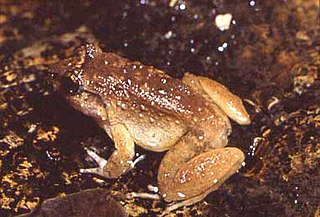
The Koh Chang frog or Koh Chang wart frog is a species of frog in the family Dicroglossidae. It is found in east Thailand and southern Cambodia. Records from Laos and Vietnam represent other species.
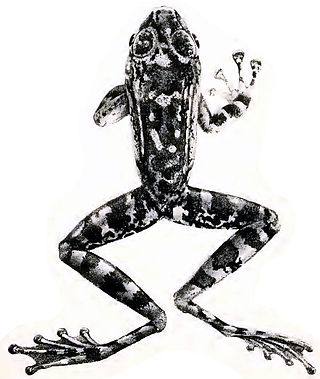
Amolops larutensis is a species of frog in the family Ranidae that is found in the Malay Peninsula from southernmost Thailand to Malaysia; records further north probably represent A. panhai.
The Malesian frog, Malaysian river frog, Malaysian peat frog, or peat swamp frog is a species of frog in the family Dicroglossidae. It is found on the Malay Peninsula, Sumatra, Java, Borneo, and a range of islands on the Sunda Shelf . Its natural habitats are shallow, gentle streams and nearby swampy areas including peat swamps, very flat alluvial forests, and overgrown plantations. It is becoming rare due to habitat loss (deforestation), and to a lesser extent, exploitation.
Odorrana andersonii is a species of frog in the family Ranidae.

The common green frog is a frog species of in the true frog family Ranidae; some sources still use the old name Rana erythraea. It lives in Southeast Asia and is also known as green paddy frog, red-eared frog or leaf frog. The last name, however, commonly refers to the Neotropical tree frogs which make up the subfamily Phyllomedusinae. These are not closely related to H. erythraea, belonging to family Hylidae instead.

Sylvirana faber is a species of frog in the family Ranidae. It is found in Cambodia and possibly Thailand.

Hylarana guentheri is a species of frog in the family Ranidae. It was formerly placed in the genus Rana. It is found in China, Hong Kong, Macau, Taiwan, Vietnam, and possibly Cambodia and Laos. An introduced population is found on Guam. It can live as high as 1100 meters above sea level. An alternate common name is Günther's Amoy frog, and the honorific is often spelled "Guenther's".
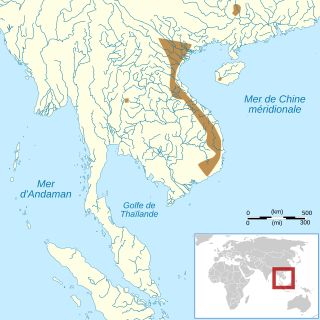
Johns' groove-toed frog or Johns' frog, is a frog species in the true frog family (Ranidae). It is found in scattered locations in southern China and Vietnam and in the Khammouan Province of Laos, eastern Cambodia, and north-central Thailand. Its natural habitats are subtropical or tropical evergreen forests where it can be found in leaf-litter and on low vegetation near streams. It breeds in paddy fields, at least. It is mostly known from protected areas without other major threats than fires. It is not considered threatened by the IUCN.
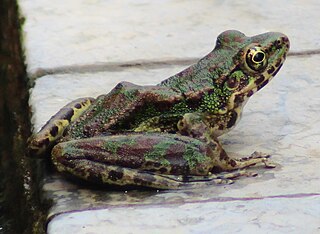
Odorrana schmackeri is a species of frog in the family Ranidae. It is endemic to China and distributed in southern and south-central China. Reports from Thailand and Vietnam require confirmation.

Sylvirana nigrovittata, also known as the black-striped frog, black-spotted stream frog, sapgreen stream frog, etc., is a species of frog in the family Ranidae. It is found in northeastern India, Bangladesh, Nepal, southern China, Myanmar, Thailand, Cambodia, Laos, and Vietnam. The species was redelimited in 2018, and earlier literature may refer to other species; identifications from India and Bangladesh are still uncertain.

Sylvirana is a genus of true frogs, family Ranidae, found in South and East Asia, from northeastern India in west to China in the north, Taiwan in the east, and Thailand in the south. Originally proposed as a subgenus of Rana in 1992, it has been considered both a full genus and a synonym of Hylarana. Its current recognition at generic level stems from molecular genetic analyses published in 2015.
Pulchrana debussyi is a species of true frog, family Ranidae. It is endemic to Sumatra, Indonesia. It is only known from its type locality in the Batak Mountains. The holotype is now lost, and there are concerns about validity of this taxon—it might be a synonym of Sylvirana nigrovittata. Common name Battak frog has been proposed for it.
Hylarana montivaga, sometimes known as Langbian Plateau frog or Chantaburi stream frog, is a species of "true frog" in the family Ranidae. Its generic placement is currently unsettled. It is known from the Langbian Plateau in southern-central Vietnam; records from elsewhere refer to other species.
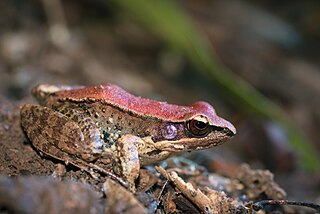
Sylvirana mortenseni is a species of true frog. It is found in Cambodia, Laos, and Thailand. The specific name mortenseni honours Ole Theodor Jensen Mortensen, the Danish zoologist who collected the holotype from the island of Koh Chang. Common names Mortensen's frog and Koh Chang Island frog have been proposed for it.

" Pulchrana signata, commonly known as the variable-backed frog, striped stream frog, spotted stream frog, or Matang frog, is a species of "true frog". It is native to the Malay Peninsula, Sumatra and Natuna Archipelago (Indonesia), and Borneo. Its occurs in lowland tropical forests, including swamp and heath forests, a altitudes up to 700 m (2,300 ft) above sea level. It is not currently considered threatened by the IUCN.
Hylarana spinulosa, also known as fine-spined frog and spiny frog, is a species of true frog, family Ranidae. It is endemic to Hainan, southern China. It occurs in tropical forests at elevations of 80–840 m (260–2,760 ft) above sea level. Breeding takes place in pools and slow-flowing streams.

Amolops panhai, commonly known as the peninsular torrentfrog, is a species of true frog that can be found in western and peninsular Thailand and in eastern Myanmar. It is associated with streams and waterfalls in moist lowland forests.















